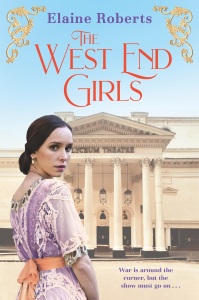Elaine is looking at our dreams and ambitions ahead of the publication of her novel The West End Girls on Thursday.

The novel is set in World War One London. The main character, Annie, in The West End Girls had a childhood dream, that wouldn’t go away, but it didn’t match what her parents wanted for her. Annie had to decide how far she would go for it. As they say nothing comes for free. She needed the support of her friends, and a wake up call, to give her the push she needed to move forward with it.
Dreams and ambitions come in many forms; they can be for you, your family, and friends or for the people of the world.
Do you have a dream? Can you share what would motivate you to try to achieve it? Can you tell people what it is? Are there people in your life that would support you if they knew about it? That support may not be directly helping with your ambition, it might be to do the ironing or other tasks to free up your time. Is it something you can put the building blocks in place for when you’re ready to take the risk of going for it?
 My ambition for as long as I can remember was to write, but life got in the way of it that is until about ten years ago. I was in my fifties then and I suddenly realised that time was running away from me. So with the support of my family I started to attend classes to learn, that was in 2012.
My ambition for as long as I can remember was to write, but life got in the way of it that is until about ten years ago. I was in my fifties then and I suddenly realised that time was running away from me. So with the support of my family I started to attend classes to learn, that was in 2012.
I also watch a poet on YouTube, Prince Ea. His poem, Everybody Dies But Not Everybody Lives, struck a very powerful cord within me and I would definitely recommend listening to it. I will add the link at the bottom of the post. I haven’t listened to all his posts so I’m only talking about this particularly poem. It made me realise I don’t want to be a ‘Kinda’ person; which is what he talks about. I wanted to at least try to achieve my dream so whenever I got down I listened to the poem again and received the much-needed boost.
Reaching your dream can be a wonderful thing, a massive feeling of achievement, but sometimes it’s not always as we imagined it would be. It took me six years to achieve my dream, it was a compromise on my original one but I’m more than happy with it.
Good luck with whatever you wish to do in life, just make sure you live it.
You Tube: Prince Ea – Everybody Dies But Not Everybody Lives
Amazon: The West End Girls

Growing up on a farm in the country, Annie Cradwell has always dreamt of singing on stage. So when she hears her friend Joyce has a room to spare in London, she sets off with best friend Rose for an adventure beyond anything they could have imagined.
In London, Annie and Rose stumble into jobs at the Lyceum Theatre. Being a dresser to capricious star Kitty Smythe wasn’t exactly what Annie had in mind. But then the musical director, Matthew Harris, offers her singing lessons. And Annie starts to wonder – could this be her chance? Or is it all too good to be true?
With the threat of war in the air, everything is uncertain. Is there a place for hopes and dreams when so much is at stake?
Annie, Rose and Joyce are three girls with very different dreams – but the same great friendship.

Elaine’s New Photo
Author Bio
Elaine Roberts had a dream to write for a living. She completed her first novel in her twenties and received her first very nice rejection. Life then got in the way again until she picked it up again in 2010. She joined a creative writing class, The Write Place, in 2012 and shortly afterwards had her first short story published. Elaine is very proud of The Foyles Bookshop Girls saga trilogy, which her late husband encouraged her to write. She, and her extended family, live in and around Dartford, Kent and her home is always busy with children, grandchildren, grand dogs and cats visiting.


 The chances of an early death were high. The local newspapers of the time are full of reports of fatal accidents. I came across over 20,000 results searching over only the four years of World War 1. Being knocked over by a runaway tram was extremely common, as was being crushed by a roof fall. Pit cages (in which men travelled down to the shafts) were occasionally known to crash and kill the occupants. Then there were the explosions, caused by the gases that accumulated, particularly firedamp. If you survived an explosion, but didn’t get out of the pit quickly, afterdamp, the toxic gas left, would quite likely see you off.
The chances of an early death were high. The local newspapers of the time are full of reports of fatal accidents. I came across over 20,000 results searching over only the four years of World War 1. Being knocked over by a runaway tram was extremely common, as was being crushed by a roof fall. Pit cages (in which men travelled down to the shafts) were occasionally known to crash and kill the occupants. Then there were the explosions, caused by the gases that accumulated, particularly firedamp. If you survived an explosion, but didn’t get out of the pit quickly, afterdamp, the toxic gas left, would quite likely see you off.
 November 1915. For young housemaid, Anwen Rhys, life is hard in the Welsh mining village of Dorcalon, deep in the Rhymney Valley. She cares for her ill mother and beloved younger sister Sara, all while shielding them from her father’s drunken, violent temper. Anwen comforts herself with her love for childhood sweetheart, Idris Hughes, away fighting in the Great War.
November 1915. For young housemaid, Anwen Rhys, life is hard in the Welsh mining village of Dorcalon, deep in the Rhymney Valley. She cares for her ill mother and beloved younger sister Sara, all while shielding them from her father’s drunken, violent temper. Anwen comforts herself with her love for childhood sweetheart, Idris Hughes, away fighting in the Great War.


 Imagine doing without your vacuum cleaner, washing machine, fan oven with controllable temperature, dishwasher, fridge and freezer. I wonder if you could live even a week without at least some of them.
Imagine doing without your vacuum cleaner, washing machine, fan oven with controllable temperature, dishwasher, fridge and freezer. I wonder if you could live even a week without at least some of them.
 You have your washing board standing in the sink, which is full of water (boiled, as you have no running hot water). You’ve made the water nice and soapy, but not with your super powerful laundry liquid or washing powder, but with a bar of soap, maybe Puritan or Sunlight. To get the clothes clean, you haven’t got the drum action of your washing machine, but have to rub them rigorously against the washing board. You’ll change the water two or three times while you’re washing. Then comes the rinsing. Seven times should do it, if you’re lucky. Next, get them them through the mangle to squeeze out excess water. Now you can put them into your basket and hang them out on the washing line, a nice long, rope one of course, none of your rotary lines. If it’s raining, you might be lucky enough to have an indoor dryer hanging from the ceiling in the kitchen, near the range.
You have your washing board standing in the sink, which is full of water (boiled, as you have no running hot water). You’ve made the water nice and soapy, but not with your super powerful laundry liquid or washing powder, but with a bar of soap, maybe Puritan or Sunlight. To get the clothes clean, you haven’t got the drum action of your washing machine, but have to rub them rigorously against the washing board. You’ll change the water two or three times while you’re washing. Then comes the rinsing. Seven times should do it, if you’re lucky. Next, get them them through the mangle to squeeze out excess water. Now you can put them into your basket and hang them out on the washing line, a nice long, rope one of course, none of your rotary lines. If it’s raining, you might be lucky enough to have an indoor dryer hanging from the ceiling in the kitchen, near the range. If you happen to be a miner’s wife, you’ll probably wash the pit clothes separately in a wooden tub in the back yard, using a dolly. As for blankets and curtains, you’ll likely wash them in the zinc bath. You’ll need to boil a few buckets of water for that.
If you happen to be a miner’s wife, you’ll probably wash the pit clothes separately in a wooden tub in the back yard, using a dolly. As for blankets and curtains, you’ll likely wash them in the zinc bath. You’ll need to boil a few buckets of water for that. temperature, spitting on the iron is favourite. Once it’s sizzling nicely, you’ll insert it into a metal cover so that the clothes aren’t soiled by the ash it might have picked up.
temperature, spitting on the iron is favourite. Once it’s sizzling nicely, you’ll insert it into a metal cover so that the clothes aren’t soiled by the ash it might have picked up. And what of cleaning? Among the items on your list each day will be scrubbing floors, beating mats, cleaning walls and windows, polishing brass, blackleading the grate, scrubbing the front step, windowsills and pavement, sweeping and dusting, emptying and filling the grate, polishing the furniture and carrying and boiling water – particularly when your husband comes home covered in coal dust. Preparing the huge zinc bath, normally carried from the scullery to the kitchen, is a whole set of jobs on its own. Talking of coal dust, the constant presence of it in the air makes your job twice as hard.
And what of cleaning? Among the items on your list each day will be scrubbing floors, beating mats, cleaning walls and windows, polishing brass, blackleading the grate, scrubbing the front step, windowsills and pavement, sweeping and dusting, emptying and filling the grate, polishing the furniture and carrying and boiling water – particularly when your husband comes home covered in coal dust. Preparing the huge zinc bath, normally carried from the scullery to the kitchen, is a whole set of jobs on its own. Talking of coal dust, the constant presence of it in the air makes your job twice as hard. November 1915. For Anwen Rhys, life is hard in the Welsh mining village of Dorcalon, deep in the Rhymney Valley. She cares for her ill mother and beloved younger sister Sara, all while shielding them from her father’s drunken, violent temper. Anwen comforts herself with her love for childhood sweetheart, Idris Hughes, away fighting in the Great War.
November 1915. For Anwen Rhys, life is hard in the Welsh mining village of Dorcalon, deep in the Rhymney Valley. She cares for her ill mother and beloved younger sister Sara, all while shielding them from her father’s drunken, violent temper. Anwen comforts herself with her love for childhood sweetheart, Idris Hughes, away fighting in the Great War.





